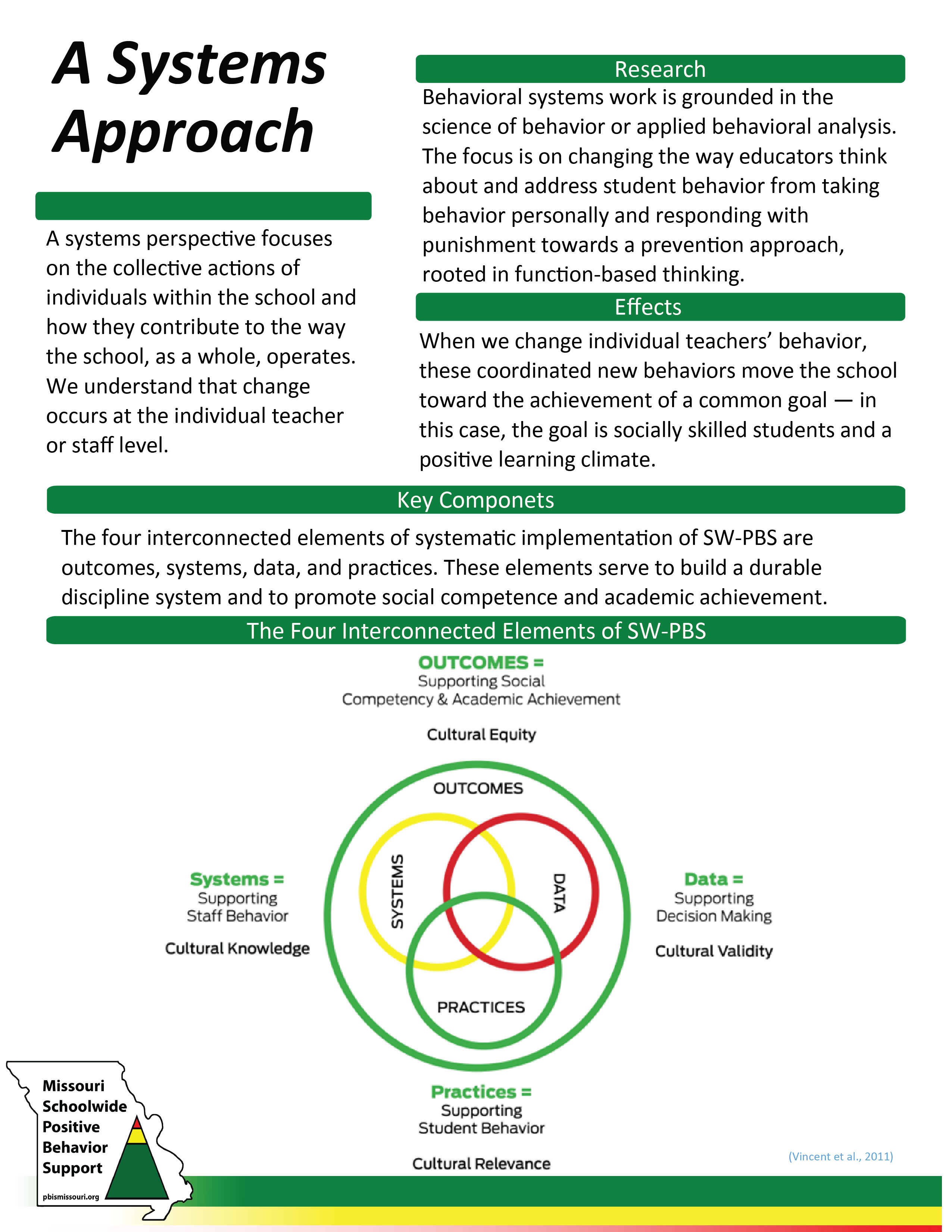SW-PBS is a systems change framework to address school climate and culture. When you embark upon implementing SW-PBS at the district and school levels, you are undertaking a change in your system of addressing culture, climate, discipline, and behavior. It becomes a change in the way your district or school does business.
Implementation is a process, not an event. Implementation will not happen all at once nor always proceed smoothly. SW-PBS provides the opportunity to take time to plan and prepare before implementation. While clear progress is essential to sustain interest in the initiative, schools who work steadily and thoroughly through preparation activities prior to implementation experience the greatest success.
This professional learning module focuses on the four interconnected elements of School-wide Positive Behavior Supports: systems, practices, data, and outcomes and helps participants understand how prevention and function-based thinking work together to produce a change in how school systems think about and address student behavior.
Course Outcomes
By the end of this course, you will…
- Identify the four elements that guide the systematic implementation of School-Wide Positive Behavior Supports (SW-PBS),
- Understand the impact of behavior problems on students and educators.
- Understand how prevention logic and function-based thinking work together to produce change in how school systems think about and address student behavior.
- Identify the key features within a Multi-Tiered System of Support.
- Understand the similarities and differences between academic Response to Intervention (RTI) and Schoolwide Positive Behavior and Supports (SW-PBS).
- Understand the tiered supports for professional learning for staff.
- Become familiar with the Four Interconnected Elements of SW-PBS,
- Understand how outcomes serve to build a durable discipline system and promote social competence and academic achievement.
- Understand the component of effective professional learning and differentiated support for staff.
- Understand how data (and data-based decision making) serve to build a durable discipline system and promote social competence and academic achievement.
Understand how the 8 Effective Teaching and Learning Practices serve to build a durable discipline system and promote social competence and academic achievement.
Recommended Prerequisites
This Professional Learning Module is the prerequisite for all of the behavioral Professional Learning Modules that follow.
Reflective Questions
As you consider your current district, building, and classroom framework for supporting all students through positive and proactive strategies and interventions:
- How are the systems aligned across all settings to create equitable access to academic, social, emotional, and behavioral curriculum?
- What types of data sources are being used to make decisions for both academic and behavior support for all students?
- How is the fidelity of implementation of Effective Teaching and Learning Practices (ETLPs) monitored (annually and ongoing)?
- What is the “Why” behind your systems, data, and practices for all staff, students, and stakeholders?
At the end of each lesson within A Systems Approach Professional Learning Module, there are three documents that are linked to support your thoughts and learning. Please take a moment to download each of these items as you prepare to move through each of the lessons.
- HO 1 MO SW-PBS A Systems Approach Guided Notes: A document that contains each lesson’s outcomes, key terms, and guided questions and reflections to provide you with a space to jot down any thoughts, connections, and questions as you work through the content.
- HO 2 MO SW-PBS Blank Action Plan: A blank action plan template that identifies key features of a three-tiered model to support the implementation of systems, data, and practices to increase positive outcomes for all students.
- HO 3 MO SW-PBS Tier 1 Artifacts Rubric: A tool you can use to assess the quality of your work. This resource helps your team review and qualify the artifacts you have developed and piloted. For instance, it can be used to ensure that you utilize efficient and effective systems for data collection, produce high-quality data reports for decision making, and develop lesson plans that include all critical elements for universal, targeted, or individual teaching of schoolwide, non-classroom, and classroom expectations.



